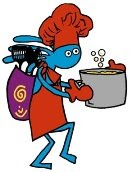Happy Holidays from Kokopelli's Kitchen! We found and have posted below some delightful holiday treats -- any of these would make a great gift for that special someone you love. The recipes are from "Christmas in Texas" edited by Marie Cahill; permission to reprint the recipes has been granted by Golden West Publishers in Phoenix, Arizona.
CHRISTMAS SWEET POTATO PIE
Amber Combs, Seven Points
1 deep dish PIE CRUST
3 cups SWEET POTATOES, cooked and mashed
1 cup SUGAR
2 EGGS
1/2 cup BUTTER, softened
1/2 tsp. NUTMEG1/4 tsp. SALT
1 cup HALF & HALF
1 cup PECANS, chopped
1/2 cup RED and GREEN CANDIED CHERRIES
Preheat oven to 375 degrees. In a medium bowl, beat sweet potatoes until smooth and add sugar, eggs, butter, nutmeg, salt and half & half. Pour filling into uncooked pie shell to 1/2 inch from top of crust. Sprinkle nuts on top. Bake for 60 to 70 minutes or until a knife inserted in center of pie comes out clean. Sprinkle red and green candied cherries over nuts. Let cool completely before cutting. Serves 6 - 8.
DOUBLE CHOCO-CHERRY CAKE
"I experimented with this cake for my best friend's husband who loves chocolate. His birthday is December 22nd, and I make it for him then, just in time for Christmas!" Dorothy Geroianni, San Antonio
1 pkg. DARK CHOCOLATE CAKE MIX
1 can (21 oz.) CHERRY PIE FILLING
1 pkg. (12 oz.) SEMI-SWEET CHOCOLATE CHIPS
Prepare cake mix according to directions on package. Pour into a greased and floured 9 x 13 pan. Spoon cherry pie filling over cake mix and swirl through. Add ½ of the chocolate chips to the batter and swirl again. Bake as directed on cake mix package. While still warm, sprinkle remaining chocolate chips over cake; the chips will melt -- spread over top of cake while warm. Cool cake and serve.
DOUBLE LAYER PUMPKIN PIE
"My holiday guests always request this pie. It has all the usual ingredients and a few delectable extras that make it a real topper. Preparation time is only 15 minutes plus refrigeration time." Helen Ruetten, Elm Mott
Crust:
20-22 squares HONEY FLAVORED GRAHAM CRACKERS
2 Tbsp. SUGAR
6 Tbsp. BUTTER or MARGARINE, softened
Crush crackers with rolling pin on wax paper. Combine with remaining ingredients in mixing bowl, stirring to blend well. Press mixture firmly in a 9-inch pie plate. Bake at 350 degrees for 8 minutes. Cool before filling.
Filling:
1 pkg. (3 oz) CREAM CHEESE, softened
1 Tbsp. HALF & HALF
1 Tbsp. SUGAR
1 1/2 cups WHIPPED TOPPING, thawed
1 1/2 cups WHIPPED TOPPING, thawed
1 cup cold HALF & HALF
2 pkg. (4 serving size) VANILLA FLAVOR INSTANT PUDDING
1 can (16 oz.) PUMPKIN
1 tsp. ground CINNAMON
1/2 tsp. ground GINGER
1/2 tsp. ground CLOVES
Mix softened cream cheese, 1 tablespoon half & half and sugar until smooth. Gently stir in whipped topping. Spread on bottom of crust. Pour 1 cup half & half into mixing bowl. Add pudding mix and beat with wire whisk 1 to 2 minutes until well blended. Let stand 5 minutes or until thickened. Stir in pumpkin and spices and mix well. Spread over cream cheese layer. Refrigerate 2 hours or overnight. Garnish with additional whipped topping and chocolate dipped pecan halves, if desired. Serves 8.
1/2 tsp. ground GINGER
1/2 tsp. ground CLOVES
Mix softened cream cheese, 1 tablespoon half & half and sugar until smooth. Gently stir in whipped topping. Spread on bottom of crust. Pour 1 cup half & half into mixing bowl. Add pudding mix and beat with wire whisk 1 to 2 minutes until well blended. Let stand 5 minutes or until thickened. Stir in pumpkin and spices and mix well. Spread over cream cheese layer. Refrigerate 2 hours or overnight. Garnish with additional whipped topping and chocolate dipped pecan halves, if desired. Serves 8.










